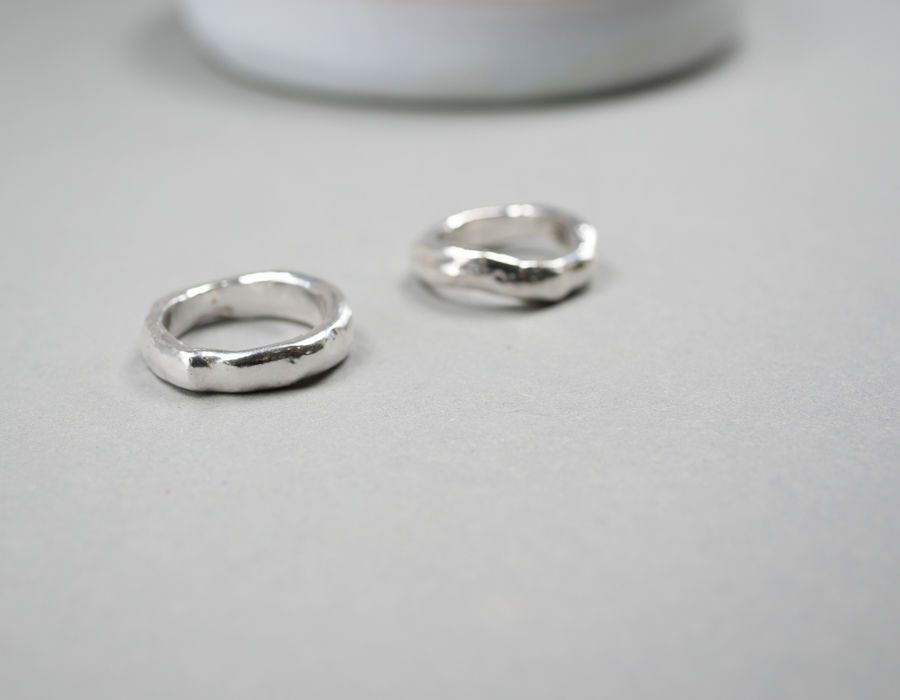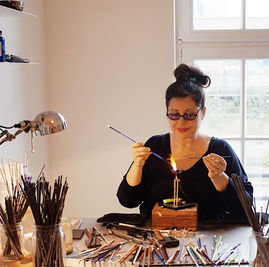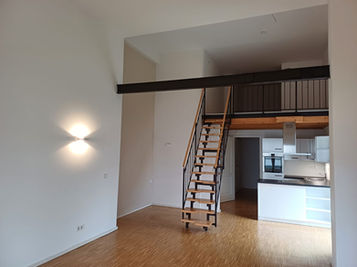
MELANIE MOERTEL – HANDBLOWN GLASS JEWELRY
Melanie creates unique glass jewelery (necklaces, pendants, earrings, rings) in her Leipzig studio.
The careful production gives the handmade glass beads a very special stability. Glass is also sustainable and hypoallergenic.

MELANIE MOERTEL – GLASS ARTIST
Combining technical perfection with playful ease - that's what appeals to me when working with hot glass.
When designing my glass beads, I make sure to combine traditional craftsmanship with modern design elements in order to create something new.In addition to exhibitions at home and abroad (including Pismo Art Gallery, KOBE Lampwork Museum, Glasmuseum Wertheim) I have taught my bead designs and techniques in workshops worldwide, and organized and carried out Germany-wide glass events for a Danish jewelry brand. Today my focus is on glass and jewelry design.
Publications & TV
2018 // ARD (ARD Buffet)
2017 // Saxony TV (Saxony mirror), MDR (thunder weather)
2004 // Franconia television
Magazines and Books
GlassLine (USA) / Bead & Button (USA)/ private room (Germany)/ The Beader's Guide to Jewelry Design (USA)/ Art from the Flame (Germany)/ 1000 Beads (USA)/ Showcase 500 Beaded Jewelry (USA)/ Oregon Life (USA)/ The Flow, #3 & #4 (US)/ Totally Twisted (USA)/ Caution Glass, No. 1, 2, 3, 6 (Germany)/ Glass...pearls...eigenART, (Germany)/ Ma Vie (Germany)
A LOOK BEHIND THE SCENES
My new studio will open in March/April 2026 in Bamberg.
I’m already looking forward to presenting my work in a larger, light-filled space. Visits to the studio are welcome by appointment, and anyone wishing to get creative themselves can find all information about my workshops in the corresponding menu section.
My working process: Since 2003, I have been working with traditional Murano glassmaking techniques, creating every single glass bead by hand over an open flame. At the torch, the glass is wrapped layer by layer around a metal mandrel, shaped, and designed. Depending on the size, color, and design, making just one bead can take up to an hour. Afterwards, it is kiln-annealed to relieve internal stress and ensure maximum durability.
The raw material I use is high-quality Murano glass rods, valued for centuries for their exceptional purity, brilliance, and color intensity. In addition to classic Italian and American soft glass, I also work with particularly durable borosilicate glass, known for its robustness and clarity.
A small piece of tradition in every bead.
Coming soon to Bamberg: Starting in 2026, you will be able to experience my work firsthand in my new studio in Bamberg. There, you’ll have the opportunity to see my glass beads and jewelry up close, feel the materials, and gain insight into the creation process—personally and in a calm studio atmosphere.
I’m already looking forward to your visit!
YOUR FEEDBACK
*****
"Hello Again :) Heute kam es an... wow... Braucht es irgendwelche Worte? Das Armband ist so unfassbar toll. Ich bin begeistert ohne Ende. Auch der Karabiner - komme super damit klar. Das Armband sitzt perfekt. Jede einzelne Perle is megaschön, sie haben genau die richtige Größe. Liebe Melanie ich bin einfach hin und weg... Vielen vielen lieben Dank. (...)"
Kundin D. (05.03.25)
*****
"Liebe Frau Mörtel, cooles Armband - das erinnert mich von den Farben total an die 70er. Und die Perlen sind alle handgemacht? Toll!! Danke fürs Anfertigen :-)"
Kundin T. (07.06.22)
*****
"Hallo Melanie- Ihre Post ist heute angekommen. Die Perle ist wunderschön. Auch meine Frau hat sich sehr über sie gefreut. Dabei kam das Geschenk gerade zum richtigen Zeitpunkt an, den heute, am 08.08. ist unser Hochzeitstag."
Kunde P. (08.08.17)
*****
"Hallo Melanie, Das Armband ist heute morgen angekommen. Es passt perfekt und ist wunderschön. Vielen Dank! Ich wünsche Dir ein schones Wochenende!"
Kundin I. (30.08.13)
*****
"Liebe Frau Moertel, herzlichen Dank für die Zusendung. Alles gut angekommen. Vielen Dank für das liebevolle Verpacken und Ihr Geschenk. Ihnen ein schönes Wochenende."
Kundin C. (24.01.25)
*****
"Liebe Melanie, heute ist das Päckchen von Dir angekommen. In freudiger Erwartung habe ich es erst einmal beiseite gelegt. Ich wollte den Augenblick bewusst genießen und dabei Zeit für mich haben. Daher habe ich mich erst am späten Abend aufgeregt ans Auspacken gemacht. Es ist nicht irgendein Versandgut, was angekommen ist. Deine Lieferung erreicht mich mit viel Herz und Seele. Ich liebe Deine kleinen Kunstwerke. Es ist meine zweite Bestellung bei Dir. Beim ersten Mal habe ich mir liebe Menschen beschenkt, dieses Mal ging es nur um mich. Als ich mein neues Armband ausgepackt habe, hatte ich Tränen in den Augen. Es ist wunderschön – und noch so vieles mehr. Ich trage eigentlich keinen Schmuck, und dennoch ist es die zweite Situation in meinem Leben, dass ich mich bewusst und selbst mit einem symbolträchtigen Schmuckstück beschenkt habe. Es bedeutet mir sehr viel, und ich möchte Dir von Herzen danken. (...)"
Kundin M. (23.04.20)

KONTAKT
Adresse ab Februar/März 2026
Alte Seilerei 22 (1. OG)
96052 Bamberg
Kontakt
Am besten erreichst Du mich per
Öffnungszeiten
Gerne heiße ich Dich nach Terminvereinbarung willkommen














































